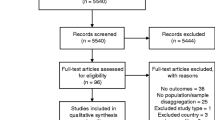Abstract
HIV prevalence was estimated among migrants in transit through Mexico. Data were collected on 9108 Central American migrants during a cross-sectional study performed in seven migrant shelters from 2009 to 2013. Considerations focused on their sociodemographic characteristics, sexual and reproductive health, and experience with violence. Based on a sample of 46.6 % of respondents who agreed to be HIV tested, prevalence of the virus among migrants came to 0.71 %, reflecting the concentrated epidemic in their countries of origin. A descriptive analysis was performed according to gender: the distribution of the epidemic peaked at 3.45 % in the transvestite, transgender and transsexual (TTT) population, but fell to less than 1 % in men and women. This gender differential is characteristic of the epidemic in Central America. Furthermore, 23.5 % of TTTs and 5.8 % of women experienced sexual violence. The predominant impact of sexual violence on TTTs and women will influence the course of the AIDS epidemic.

Similar content being viewed by others
References
Quinn TC. Population migration and the spread of types 1 and 2 human immunodeficiency viruses. Proc Natl Acad Sci. 2004; 91(7): 2407–2414.
Lydié N, Robinson NJ, Ferry B, Akam E, De Loenzien M, Abega S. Study group on heterogeneity of HIV epidemics in African cities: mobility, sexual behavior, and HIV infection in an urban population in Cameroon. J Acquir Immune Defic Syndr. 2004;35(1):67–74.
Joffe H. Risk: from perception to social representation. Br J Soc Psychol. 2003;42(1):55–73.
Sparke M, Anguelov D. H1N1, globalization and the epidemiology of inequality. Health Place. 2012;18(4):726–36.
Jatrana S, Graham E, Boyle P. Introduction: understanding migration and health in Asia. In: migration and health in Asia, London: Routledge; 2005. p. 1–16.
Infante C, Aggleton P, Pridmore P. Forms and determinants of migration and HIV/AIDS-related stigma on the Mexican–Guatemalan border. Qual Health Res. 2009;19(12):1656–68.
Pan X, Zhu Y, Wang Q, Hui Z, Xin C, Jing S, Zhihang P, Ronghin Y, Ning W. Prevalence of HIV, syphilis, HCV and their high risk behaviors among migrant workers in eastern China. PLoS ONE. 2013;8(2):e57258.
Tavora L, Teodisio R, Seixas J. Sexually transmitted infections in an African migrant population in Portugal: a base-line study. J Infect Dev Ctries. 2007;1(3):326–8.
Poudel KC, Okumura J, Sherchand JB, Jimba M, Murakami I, Wahai S. Mumbai in far western Nepal: HIV infection and syphilis among male migrant-returnees and non-migrants. Trop Med Int Health. 2003;8(10):933–9.
Welz T, Hosegood V, Jaffar S, Bätzing-Feigenbaum J, Herbst K, Newell ML. Continued very high prevalence of HIV infection in rural KwaZulu-Natal, South Africa: a population based longitudinal study. AIDS. 2007;21(11):1467–72.
Harawa N, Trista A, Bingham TA, Cochran S, Greenland S, Cunnigham W. HIV Prevalence Among foreign- and US-born clients of public STD clinics. J Public Health. 2002;92(12):1958–63.
Martínez DA, Rangel MG, Hovell MF, Santibañez J, Sipan C, Izazola J. HIV infection in mobile populations: the case of Mexican migrants to the United States. Pan Am J Public. 2005;17(1):26–9.
Rangel MG, Martinez-Donate AP, Hovell MF, Sipan C, Zellne C, Gonzalez-Fagoaga E, Kelley N, Asadi-Gonzalez A, Amuedo-Dorantes C, Magis-Rodriguez C. A two-way road: rates of HIV infection and behavioral risk factors among deported Mexican labor migrants. AIDS Behav. 2012;16(6):1630–40.
UNAIDS: Joint United Nations Programme on HIV/AIDS. The gap report. Geneva; 2014.
Rodriguez E. Migración centroamericana en tránsito por México hacia Estados Unidos: Diagnóstico y recomendaciones Hacia una visión integral, regional y de responsabilidad compartida. México: ITAM; 2014.
Rodríguez E, Berumen S, Ramos LF. Migración centroamericana de tránsito irregular por México. Estimaciones y características generales. Apuntes sobre Migración. Instituto Nacional de Migración. Centro de estudios migratorios 2011; 1: 1–8.
Infante C, Silván R, Caballero M, Campero L. Sexualidad del migrante: experiencias y derechos sexuales de centroamericanos en tránsito a los Estados Unidos. Salud Pública de México. 2013;55:S58–64.
Bronfman M, Leyva R, Negroni M, Rueda C. Mobile populations and HIV/AIDS in Central America and Mexico: research for action. AIDS. 2002;16:S42–9.
Servan-Mori E, Leyva-Flores R, Infante C, Torres-Pereda P, Garcia-Cerde R. Migrants suffering violence while in transit through Mexico: factors associated with the decision to continue or turn back. J Immigr Minor Health. 2014;16:53–9.
BioLytical. INSTI HIV-1 antibody test. Summary of safety and effectiveness. Richmond, BC, Canada. http://www.fda.gov/downloads/BiologicsBloodVaccines/BloodBloodProducts/ApprovedProducts/PremarketApprovalsPMAs/UCM235253.pdf.
CENSIDA: Guía para la aplicación de la prueba rápida. México, DF: Secretaria de Salud; 2006.
NOM-010-SSA2-2010: Norma Oficial Mexicana para la Prevención y el Control de la Infección por el Virus de la Inmunodeficiencia Humana. México, DF: Secretaría de Salud; 2010.
Goldenberg S, Strathdee S, Perez-Rosales M, Sued O. Mobility and HIV in Central America and Mexico: a critical review. J Immigrt Minor Health. 2011;14(1):48–64.
Rosner B. Fundamentals of biostatistics. 7th ed. Canada: Brooks/Cole. CENGAGE Learning; 2011.
Greenwood PE, Nikulin MS. A guide to Chi squared testing. Wiley; 1996.
Stata Corp. LP. Stata/SE 13.0 College Station Texas, U. S. C. L. 1985–2013.
PNUD: Acceso Universal. De la Vulnerabilidad a la resiliencia. Marco estratégico de América Latina y el Caribe para el fortalecimiento de las respuestas nacionales al VIH para hombres gay, otros HSH y personas trans. Panamá: Programa de Naciones Unidas para el Desarrollo; 2010.
CENSIDA: El VIH/SIDA en México 2012. Secretaria de Salud, Ciudad de México, Secretaría de Salud; 2012.
Author information
Authors and Affiliations
Corresponding author
Rights and permissions
About this article
Cite this article
Leyva-Flores, R., Infante, C., Servan-Mori, E. et al. HIV Prevalence Among Central American Migrants in Transit Through Mexico to the USA, 2009–2013. J Immigrant Minority Health 18, 1482–1488 (2016). https://doi.org/10.1007/s10903-015-0268-z
Published:
Issue Date:
DOI: https://doi.org/10.1007/s10903-015-0268-z




